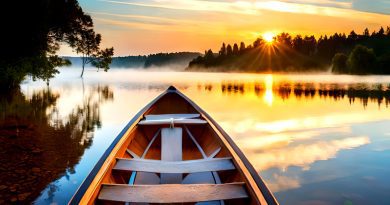
What Should I Know About Canoeing In Different Water Conditions?
Navigating the Waters:
What should I know about canoeing in different water conditions? Understanding how various environments affect your canoeing experience is essential for both safety and enjoyment.
Canoeing offers a unique connection with nature, but different water conditions—from serene lakes to rushing rivers—demand different techniques and preparations. Whether you’re a novice or an experienced paddler, knowing how to adapt to these conditions is crucial.
The Options and Obstacles
- Lakes:
- Calm Waters: Ideal for beginners, providing a controlled environment to practice basic strokes and maneuvers. However, wind and waves can pose challenges.
- Obstacles: Wind can create waves and strong currents, making navigation and stability more difficult.
- Rivers:
- Slow-Moving Rivers: Good for leisurely paddling and practicing technique. Be aware of changing currents and potential obstacles like rocks and branches.
- Fast-Moving Rivers: Require advanced skills to navigate rapids and strong currents. Proper technique and safety measures are critical.
- Whitewater:
- Rapids: Classified from Class I (easy) to Class VI (extreme), whitewater canoeing demands high levels of skill and experience. Safety gear and knowledge of rescue techniques are essential.
- Coastal Waters:
- Bays and Inlets: Offer a mix of calm and rough waters. Tidal currents and weather changes can significantly impact paddling conditions.
- Open Sea: Only for highly experienced paddlers due to unpredictable conditions, strong currents, and large waves.
The Best Solution and Its Implementation
To successfully canoe in different water conditions, follow these guidelines:
- Understanding and Preparing for the Conditions:
- Lakes: Pay attention to wind patterns. Paddle close to the shore in windy conditions and learn to brace against waves. Practice techniques like the J-stroke to maintain a straight course.
- Rivers: Learn to read the water. Identify the smoothest paths through rapids and use draw and pry strokes for maneuvering around obstacles. Distribute weight evenly in the canoe for stability.
- Whitewater: Use advanced strokes like the high brace and low brace to maintain stability. Always wear a helmet and a properly fitted PFD. Paddle with a partner and practice rescue techniques.
- Coastal Waters: Check tide charts and weather forecasts. Use a spray skirt to keep water out of the canoe, and learn to ferry your canoe across currents by angling it at 45 degrees to the flow.
- Essential Techniques:
- Forward Stroke: The most basic stroke for propelling the canoe forward. Keep your paddle close to the canoe and use your core muscles for power.
- Backward Stroke: Used for slowing down or stopping the canoe. Similar to the forward stroke but in reverse.
- Draw Stroke: Moves the canoe sideways, useful for maneuvering in tight spaces.
- Pry Stroke: Opposite of the draw stroke, it pushes the canoe away from the paddle.
- Sweep Stroke: Used for turning the canoe. A wide, sweeping motion from the bow to the stern.
- Safety and Gear:
- PFD: Always wear a personal flotation device.
- Helmet: Essential for whitewater and rocky river conditions.
- Dry Bags: Keep your gear dry and secure.
- Map and Compass: For navigation, especially in unfamiliar waters.
- First Aid Kit: Always have a basic first aid kit on hand.
- Communication Device: Carry a waterproof phone or radio for emergencies.
Conclusion: Embracing the Journey
As I paddled back to shore, the lessons of the water conditions became clear. Each environment offers its own challenges and rewards, demanding respect and preparation. By understanding the nuances of lakes, rivers, whitewater, and coastal waters, you can paddle with confidence and safety.
Canoeing is not just about the destination but also the journey and the skills you develop along the way. Embrace the adventure, respect the water, and paddle on, knowing you’re equipped for any condition.






